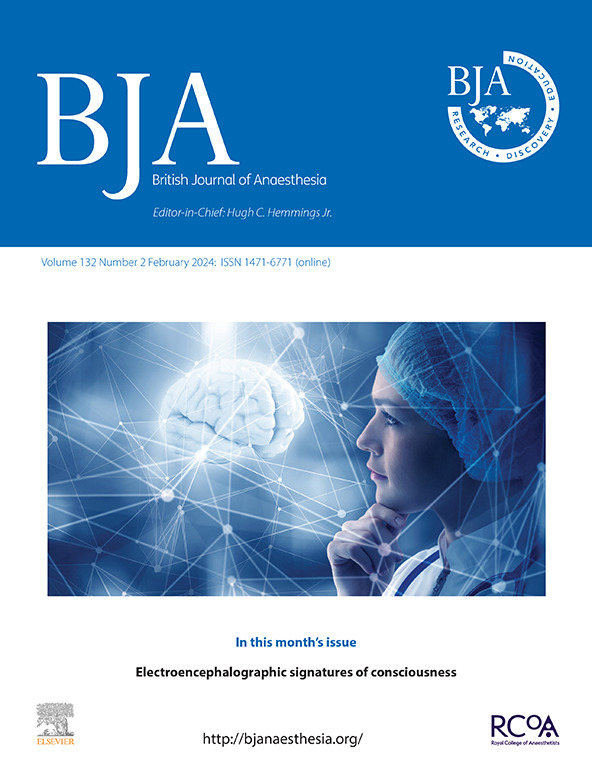Patterns of prevention effectiveness in postoperative neurocognitive disorder and delayed neurocognitive recovery research: a systematic review with meta-regression of randomised trials
IF 9.2
1区 医学
Q1 ANESTHESIOLOGY
引用次数: 0
Abstract
Background
Postoperative neurocognitive disorder and delayed neurocognitive recovery (pNCD/dNCR) are common yet unresolved complications after surgery.
Methods
We conducted a systematic literature search in resources of Ovid MEDLINE, EMBASE, Web of Science, and ClinicalTrials.gov and multivariable meta-regression analyses of RCTs to identify trial-level characteristics associated with prevention effectiveness in pNCD/dNCR research. Trials investigating pNCD/dNCR prevention in adult surgical patients were eligible. Trials performed in paediatric patients or assessing cognitive changes on the same day of surgery were excluded. Effectiveness associated with trial-level characteristics was assessed using ratio of odds ratio (OR) and 95% confidence interval (CI).
Results
We analysed 187 eligible trials. Trials originating from the USA/Canada (ratio of OR, 3.04; 95% CI, 1.62–5.73; P=0.001), Europe/Australia/New Zealand (1.58; 1.04–2.40; P=0.033), and other regions (2.0; 1.19–3.36; P=0.009) were associated with reduced effectiveness compared with trials from China. Higher pNCD/dNCR incidence in control groups was associated with greater effectiveness (0.98; 0.97–0.99; P<0.001). Trials involving volatile anaesthetics (2.12; 1.16–3.86; P=0.014) were associated with reduced effectiveness compared with dexmedetomidine and abdominal surgery, respectively. Registered trials exhibited enhanced effectiveness (0.69; 0.50–0.95; P=0.022), whereas those with power analyses reported reduced effectiveness (1.43; 1.06–1.94; P=0.021). Trials with a high risk of bias in the selection of the reported result were associated with reduced effectiveness (2.99; 1.04–8.59; P=0.041). Dexmedetomidine was the most studied intervention, showing potential benefits, though evidence certainty was very low.
Conclusions
Trial-level characteristics were significantly associated with prevention effectiveness in pNCD/dNCR research. Identifying and addressing the underlying causes of regional differences might enhance the quality and consistency of future trials on a global level.
Systematic review protocol
PROSPERO (CRD42024543584).
术后神经认知障碍和延迟神经认知恢复研究的预防效果模式:随机试验荟萃回归的系统综述。
背景:术后神经认知障碍和延迟神经认知恢复(pNCD/dNCR)是手术后常见但尚未解决的并发症。方法:我们在Ovid MEDLINE、EMBASE、Web of Science和ClinicalTrials.gov数据库中进行了系统的文献检索,并对随机对照试验进行了多变量荟萃回归分析,以确定与pNCD/dNCR研究中预防有效性相关的试验水平特征。研究成人手术患者预防pNCD/dNCR的试验符合条件。在儿科患者中进行的试验或在手术当天评估认知变化的试验被排除在外。使用比值比(OR)和95%置信区间(CI)评估与试验水平特征相关的有效性。结果:我们分析了187项符合条件的试验。来自美国/加拿大的试验(OR比3.04;95% ci, 1.62-5.73;P=0.001),欧洲/澳大利亚/新西兰(1.58;1.04 - -2.40;P=0.033),其他地区(2.0;1.19 - -3.36;P=0.009)与中国试验相比,有效性降低相关。对照组较高的pNCD/dNCR发生率与较高的疗效相关(0.98;0.97 - -0.99;结论:在pNCD/dNCR研究中,试验水平特征与预防效果显著相关。确定和解决区域差异的根本原因可能会提高未来全球一级试验的质量和一致性。系统评价方案:PROSPERO (CRD42024543584)。
本文章由计算机程序翻译,如有差异,请以英文原文为准。
求助全文
约1分钟内获得全文
求助全文
来源期刊
CiteScore
13.50
自引率
7.10%
发文量
488
审稿时长
27 days
期刊介绍:
The British Journal of Anaesthesia (BJA) is a prestigious publication that covers a wide range of topics in anaesthesia, critical care medicine, pain medicine, and perioperative medicine. It aims to disseminate high-impact original research, spanning fundamental, translational, and clinical sciences, as well as clinical practice, technology, education, and training. Additionally, the journal features review articles, notable case reports, correspondence, and special articles that appeal to a broader audience.
The BJA is proudly associated with The Royal College of Anaesthetists, The College of Anaesthesiologists of Ireland, and The Hong Kong College of Anaesthesiologists. This partnership provides members of these esteemed institutions with access to not only the BJA but also its sister publication, BJA Education. It is essential to note that both journals maintain their editorial independence.
Overall, the BJA offers a diverse and comprehensive platform for anaesthetists, critical care physicians, pain specialists, and perioperative medicine practitioners to contribute and stay updated with the latest advancements in their respective fields.

 求助内容:
求助内容: 应助结果提醒方式:
应助结果提醒方式:


